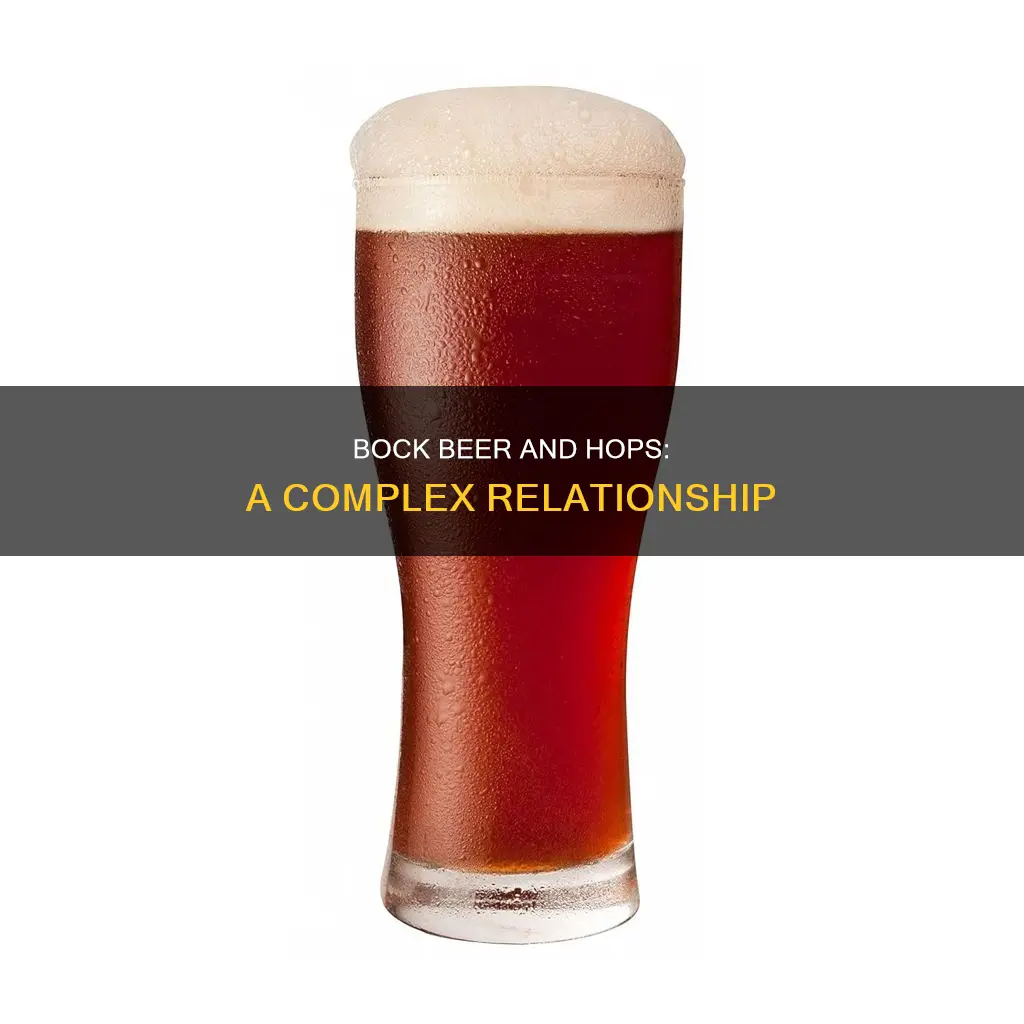
Bock is a strong German beer, usually a dark lager, with a long history dating back to the 14th century. The style originated in the northern German town of Einbeck, in the region of Lower Saxony, which was part of a federated trading group known as the Hanseatic League. This early version of the beer was brewed with pale malts and wheat, and stored cold until spring to increase clarity and reduce bacteria. Over time, the style evolved and spread to the city of Munich in Bavaria, where it became known as Bock due to the local accent and language differences. Today, Bock beer is characterised by its strong maltiness, toastiness, and low hop aroma and flavour. While hops are used in the brewing process, they contribute only a subtle bitterness to balance the sweetness of the malt, resulting in a smooth and easy-drinking beer.
What You'll Learn
- Bock beer is a strong German beer, usually a dark lager
- It is a bottom-fermenting lager with extra time in cold storage to smooth intense flavours
- It is traditionally associated with religious festivals such as Christmas, Easter, or Lent
- Maibock is a paler, more hopped version of bock beer
- Doppelbock is a stronger, maltier version

Bock beer is a strong German beer, usually a dark lager
In the 17th century, the style moved south to Munich, where the local brewers combined their own processes with those of Einbeck to create bock beer. The name "bock" is said to come from the mispronunciation of "Einbeck" as "ein bock" by Bavarians, which means "billy goat" in German. The image of a billy goat still adorns bock labels today.
Bock beer is a bottom-fermenting lager, typically spending extra time in cold storage to smooth out the intense flavours that develop during brewing. It is stronger than a typical lager, with an ABV range of 6 to 7 percent, and has a very smooth mouthfeel and low carbonation. The colour ranges from dark amber to dark brown, often with mahogany highlights.
Bock beer is characterised by its strong maltiness and toastiness, with very little hop aroma. The malt contributes to significant sweetness, balanced with strong notes of toasted nuts. There are several substyles of bock beer, including Maibock, which is paler and has more hops, and Doppelbock, which is heavier, darker, and maltier.
Hops' Preservative Powers: Keeping Beer Fresh
You may want to see also

It is a bottom-fermenting lager with extra time in cold storage to smooth intense flavours
Bock beer is a bottom-fermenting lager. This means that it is brewed using a yeast that works effectively at lower temperatures, between 5°C and 10°C (41°F and 50°F). Bottom-fermenting yeasts create carbon dioxide more slowly, resulting in less turbulence in the beer. This type of yeast is usually associated with lager yeasts.
The term "bottom fermentation" was first used in Bavaria in 1420. Brewers in this region found that they could ferment and store beer in the cool caves at the foothills of the Alps, even during the summer months. In these caves, a new type of yeast emerged that could ferment at cold temperatures. This yeast fermented more slowly and less vigorously than ale yeast, and when finished, it sank to the bottom of the vessel. This is where it was collected and used in the next batch of beer, and over time, this type of yeast became known as "bottom-fermenting" yeast.
Bock beer, being a bottom-fermenting lager, also spends extra time in cold storage to smooth out intense flavours. This process is known as "lagering". During lagering, the beer is stored in cold conditions, such as caves, to allow it to mature and develop its flavour.
Bock beer has a long history, dating back to the Medieval era in Germany. It was originally brewed in the northern town of Einbeck during the 14th century and gradually moved south to Munich by the 17th century. Due to subtle language differences, the Bavarians mispronounced the beer from Einbeck as "ein bock", which means "billy goat" in German. The name and the image of the billy goat stuck, and bock beer became associated with this animal.
Bock beer is typically stronger than a standard lager, with an alcohol content between 6% and 7.5% ABV. It has a dark amber colour and robust malt flavours, with very light hoppiness. The extra time in cold storage helps to smooth out these intense flavours, creating a well-balanced and easy-drinking beer.
Hops in Beer: Vegetable or Not?
You may want to see also

It is traditionally associated with religious festivals such as Christmas, Easter, or Lent
Bock beer is a strong German beer, usually a dark lager, with a long history. The style now known as Bock was first brewed in the 14th century in the Hanseatic town of Einbeck in Lower Saxony. The style was later adopted in Bavaria by Munich brewers in the 17th century.
Bock is traditionally associated with religious festivals such as Christmas, Easter, or Lent. This association goes back to the beer's history in Bavaria, where it was brewed and consumed by monks during times of fasting. The monks' Doppelbock beer, for example, was considered "liquid bread" and was consumed during the Lenten season.
The name "Bock" is also derived from the German word for "billy goat", and the image of a goat is commonly found on Bock beer labels. This association with goats may have contributed to the beer's popularity during religious festivals, as goats are associated with strength and power.
Today, Bock beer is still enjoyed during festive occasions and is known for its smooth, rich, and malty flavor. It is often darker in color and has a higher alcohol content compared to typical lagers.
Hops in Beer: Necessary or Overrated?
You may want to see also

Maibock is a paler, more hopped version of bock beer
Bock beer is a traditional German beer that dates back to the Medieval era. It was originally brewed in the northern German town of Einbeck during the fourteenth century, and later travelled to Munich in the seventeenth century. The mispronunciation of "Einbeck" as "ein bock" by Bavarians, which means "billy goat" in German, led to the name and iconic image associated with bock beers.
Bock beers are typically dark lagers with strong malt flavours and very light hoppiness. However, there are variations within the style, including the Maibock, which is a paler and more hopped version.
Maibock, also known as Heller Bock (meaning "pale bock"), is a lighter, less malty interpretation of the traditional bock beer. It is a transitional beer, perfect for the short Bavarian spring, with a colour ranging from light amber to deep golden. This sets it apart from the darker winter bocks. Maibock is typically brewed with a base of pale pilsner malt and additions of Vienna and Munich malts, resulting in a robust malt character. It has a heavier hop presence, contributing to a drier finish and a balanced flavour profile.
The Maibock style emerged in the mid- to late-1800s, coinciding with the popularity of Pilsner and Lager beers. It is often brewed using the time-honoured decoction method, which ensures optimum conversion of grain starches into fermentable malt sugars, resulting in a higher alcohol content. After fermentation, Maibocks are matured near the freezing point for 4 to 8 weeks to achieve a well-rounded finish.
Maibocks typically have an ABV ranging from 6% to 8.7%, with a bitterness of 20-38 IBU, and medium to fast-rising bubbles. They offer a unique spring beer experience, symbolising the return to the outdoors and the transition from winter to summer.
Hops: Brewing Demand and Future Growth
You may want to see also

Doppelbock is a stronger, maltier version
Doppelbock, or Double Bock, is a stronger and maltier version of traditional German bock beer. The name "doppel" means "double" in German, indicating that this style is a bigger and more robust variation of the lower-gravity German-style bock beers. Doppelbock was originally crafted by monks in Munich and is known for its food-friendly qualities.
The colour of Doppelbock ranges from copper to dark brown, and it is characterised by a full body and a higher alcoholic content. The malt character in Doppelbock is distinct, with fresh and lightly toasted Munich-style malt flavours taking precedence over caramel or toffee malt. The sweetness of the malt is prominent but stops short of being cloying.
Doppelbock typically has an alcoholic strength ranging from 6.6% to 7.9% ABV, although some sources indicate that it can go as high as 12% or more. The bitterness level is considered low, falling within the range of 17-27 IBUs.
The aroma of Doppelbock is intensely malty, sometimes with hints of alcohol. The flavour is rich and malty, with noticeable alcoholic strength and little to no detectable hops (16-26 IBUs). The monks who first brewed Doppelbock named their beer "Salvator," which translates as "Savior."
Brewers of modern Doppelbock often include "-ator" in their beer names, a nod to the style's origins. Over 200 "-ator" Doppelbock names have been registered with the German patent office. Some popular examples of Doppelbock include Celebrator Ayinger Privatbrauerei, Troegenator Tröegs Brewing Company, and Samuel Adams Double Bock.
Beer Hops Allergy: What You Need to Know
You may want to see also
Frequently asked questions
Yes, bock beer does contain hops, but only in small quantities. The hops are used to add a touch of bitterness to the beer to prevent it from tasting overly sweet or syrupy. Bock beer is known more for its strong malt flavours and smooth mouthfeel.
Doppelbock is a stronger, maltier version of bock beer. It has a higher alcohol content, typically ranging from 7% to 12% or more by volume. Doppelbock also has a more intense malt flavour and is known for its sweetness.
Bock beer is a traditional German beer style that dates back to the 14th century. It was first brewed in the town of Einbeck, Germany, and later adopted by Munich brewers in the 17th century. Due to a mispronunciation of the word "Einbeck" by the Bavarian citizens, the beer became known as "Bock", which means "billy goat" in German. A goat is often featured on bock beer labels.







